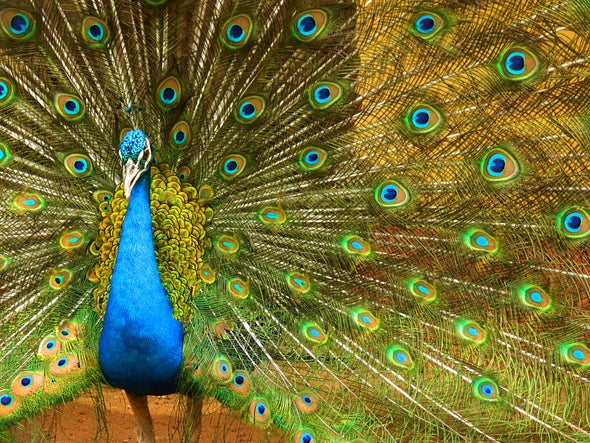(单词翻译:单击)
听力文本
This is Scientific American 60-second Science. I'm Jason Goldman.
One of the most impressive scenes in the world of birds is a peacock displaying its impressive, iridescent feathers, technically known as its train. While the female peahen looks on, the peacock spreads his train out and ruffles it back and forth as the sun highlights the red, blue, and green within the feathers.
(Train rattling sound)
But these iconic trains are only half of the story of how the boys impress the ladies. Both male and female peafowl sport crests on their heads, small feathers that stick straight up, like a Mohawk.
"The crest feathers that actually give the peacocks' their Latin name, they're called Pavo cristatus, the crested pheasant. And so I was intrigued by the fact that people didn't really know what the function of these crests were."
Haverford College physicist Suzanne Kane.
A biologist might see those feathers and assume they are visual signals, but as a physicist, Kane had a different idea.
"We were curious in my laboratory about whether the preferred vibrational properties of the crest feathers might, by any chance, agree with the preferred vibrational properties of this train-rattling display that the males do."

So the Kane and her colleagues exposed crest feathers from preserved, dead peafowls to simulated displays of male and female social behaviors, like wing-shaking and train-rattling.
"And so we were just gobsmacked to find out that they did agree."
What all that means is that the peafowls' head crests are specifically tuned to the vibrations produced by the train-rattling of its own species. The crests thus act like a sort of special antenna meant to pick up a single kind of sound. The findings are in the journal PLOS ONE.
The researchers also point out that there are at least 35 other types of birds, distributed across ten taxonomic orders, that have both head crests and displays with a vibration component.
"A lot of those kind of tactile aspects of displays are really not even very well described."
University of British Colombia zoologist Roz Dakin, who worked with Kane on this study.
"There are species that dance and vibrate on perches, and you know, the female's sharing the same perch as the male, and feeling what's going on through parts of her body like her feet. There are species where birds rub feathers on each other... What we're suggesting here is that a sensory function of feathers in social displays may be more widespread than we appreciate right now."
Seems that the females really do feel something about a particular peacock.
Thanks for listening for Scientific American — 60-Second Science. I'm Jason Goldman.
参考译文
这里是科学美国人——60秒科学。我是杰森·古德曼。
鸟类世界最令人印象深刻的场景之一,就是孔雀展示它那引人注目的彩虹色羽毛,术语称之为尾屏。当雌孔雀在一旁观看时,雄孔雀便会展开尾屏并令其来回舞动,太阳会令其羽毛内的红蓝绿三色更加闪亮。
(孔雀开屏发出的沙沙声)
但标志性尾屏只是雄孔雀打动雌孔雀的一半原因。雄孔雀和雌孔雀都会炫耀头上的羽冠,即直立的小羽毛,就像莫霍克发型一样。
“孔雀的拉丁语名字Pavo cristatus就因其羽冠而得名,意为有羽冠的野鸡。人们并不知道这些羽冠的功能,这一点引起了我的兴趣。”
哈弗福德学院的物理学家苏珊·凯恩说到。
生物学家可能会注意到这些羽毛并假设其为视觉信号,但作为一名物理学家,凯恩有不同看法。
“在我的实验室里,我们好奇的是:冠毛偏爱的振动特性是否有可能与雄孔雀‘沙沙’开屏时偏爱的振动特性相一致。”
因此,凯恩及其同事将保存下来的死亡孔雀的冠毛,暴露在雄孔雀和雌孔雀社交行为的模拟展示中,比如翅膀抖动和沙沙地开屏。
“我们惊讶地发现,二者真的一致。”
这一切意味着,孔雀的头冠是专门用来接收同类尾屏沙沙作响时所产生的振动的。这样一来,羽冠就像是接收单一声音的特殊天线。这项研究结果发生在《公共科学图书馆·综合》期刊上。
研究人员还指出,至少存在分布于10个分类目中的35种其它鸟类,既有头冠又有振动羽毛的表现。
“很多这些触觉方面的展示甚至都没有得到很好的描述。”
与凯恩一起进行这项研究的不列颠哥伦比亚大学的动物学家罗兹·达兹说到。
“有些物种会在栖木上跳舞和振动,雌性会和雄性站在同一根栖木上,用脚等身体部位感受一切。还有些鸟类会互相摩擦羽毛。我们在这里想表明的是,羽毛在社交展示中的感知功能可能比我们目前所理解的更为广泛。”
雌孔雀似乎真的能感觉到某只雄孔雀的“激情”。
谢谢大家收听科学美国人——60秒科学。我是杰森·古德曼。
译文为可可英语翻译,未经授权请勿转载!
重点讲解
重点讲解:
1. look on 旁观;
Passers-by simply looked on as he was attacked.
他遭人袭击,路人只在一边袖手旁观。
2. by any chance (用以询问某事是否属实)会不会,可能;
Are they by any chance related?
他们有可能是亲戚吗?
3. agree with 相符;吻合;与…一致;
Your account of the accident does not agree with hers.
你对事故的叙述与她的叙述不一致。
4. pick up 接收到(信号或声音);
The crew of Philante picked up a distress signal from the yacht Sans Peur III.
“菲蓝特”的船员接收到了“无畏者三号”游艇发出的遇险信号。


